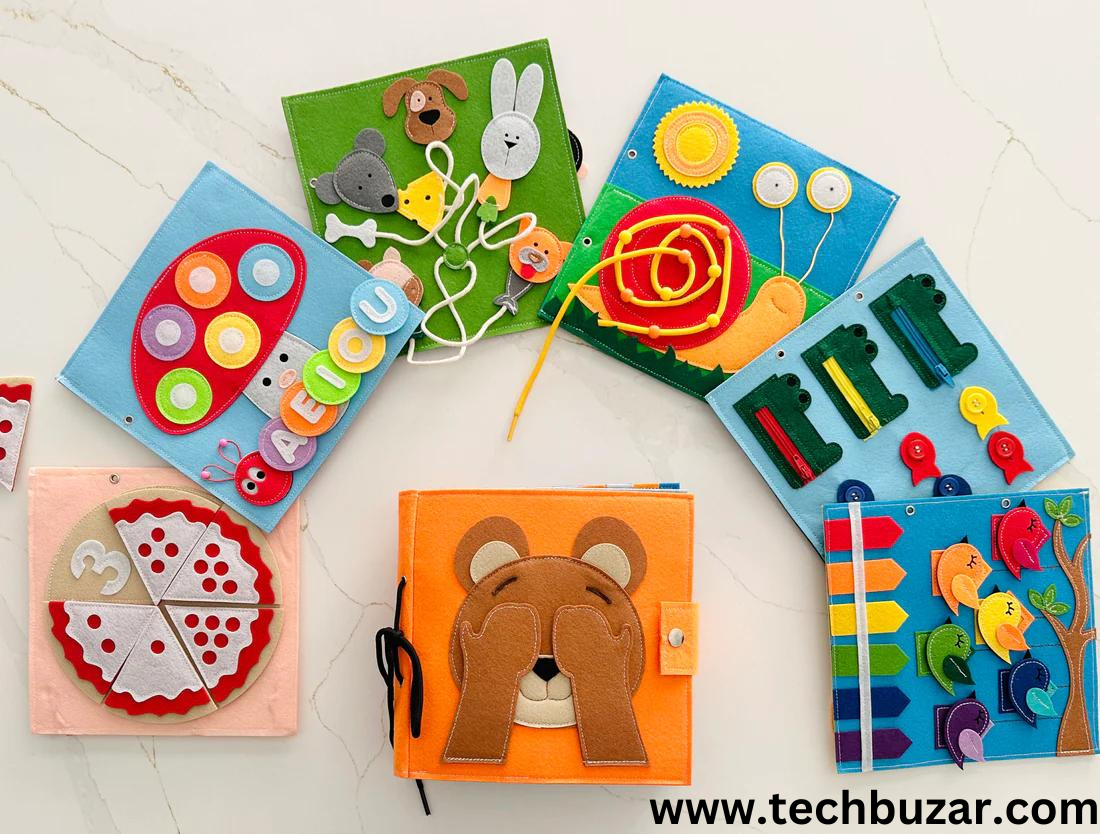
Busy Books: A Guide to 100% Interactive Learning, IS that good ?
Busy books, also known as quiet books, are interactive fabric or felt books designed to engage children in various activities. These books are filled with colorful pages featuring different textures, shapes, and activities, making them a popular choice among parents and educators for fostering early childhood development.
Benefits of Busy Books
Improves Fine Motor Skills
One of the key benefits of books is their ability to enhance fine motor skills in young children. Activities such as buttoning, zipping, and sorting require hand-eye coordination and dexterity, helping children develop essential skills for writing and other everyday tasks.
Enhances Cognitive Development
Busy books offer a wide range of activities that stimulate cognitive development in children. From shapes and colors matching to counting and sorting, these activities encourage problem-solving, critical thinking, and mathematical concepts at an early age.
Encourages Creativity
With their interactive and open-ended design, busy books inspire creativity and imagination in children. Whether they’re exploring different textures or arranging felt shapes, children have the freedom to express themselves and engage in imaginative play.
Features of Busy Books
These books come with several features that make them an ideal learning tool for young children:
Interactive Elements
Each page of a busy book is filled with interactive elements such as buttons, zippers, and Velcro tabs, providing hands-on learning experiences for children.
Varied Activities
From simple matching games to more complex puzzles, These books offer a variety of activities to keep children engaged and entertained for hours.
Durability
Constructed from durable materials like felt and fabric, These books are designed to withstand the wear and tear of daily use, making them a long-lasting investment for families.
How to Make a Busy Book
Creating a busy book is a fun and rewarding DIY project for parents and educators. Here’s a step-by-step guide to making your own busy book:
Materials Needed
- Felt or fabric
- Scissors
- Sewing machine or needle and thread
- Buttons, zippers, Velcro, and other embellishments
- Craft glue
Step-by-Step Guide
- Choose a Theme: Decide on a theme for your busy book, such as animals, numbers, or alphabet.
- Design Pages: Sketch out the layout and activities for each page of your busy book.
- Cut Fabric: Cut out the pages and shapes from felt or fabric according to your design.
- Add Activities: Attach interactive elements like buttons and zippers to each page.
- Assemble Pages: Sew or glue the pages together to create your busy book.
- Personalize: Add personalized touches like your child’s name or favorite colors to make the busy book unique.
Ideas for Busy Book Activities
Busy books offer endless possibilities for creative and educational activities. Certainly! Here are some ideas to spark your creativity:
- Shapes and Colors Matching: Create pages with different shapes and colors for children to match and sort.
- Zipper and Button Practice: Sew buttons and zippers onto pages to help children practice fine motor skills.
- Counting and Sorting: Incorporate counting activities with felt numbers and objects for children to count and sort.
Tips for Using Busy Books Effectively
To maximize the benefits of these books, consider the following tips:
- Start Simple: Begin with simple activities and gradually introduce more complex ones as your child develops.
- Rotate Activities: Keep the busy book fresh and exciting by rotating the activities regularly.
- Supervise Initially: Provide guidance and supervision as your child explores the busy book, especially with younger children.
Where to Find or Buy Busy Books
Busy books are widely available online and in stores catering to educational toys and materials. You can also find handmade books at local craft fairs or create your own using DIY tutorials and templates available online.
Busy Books for Different Age Groups
Busy books are suitable for children of all ages, from infants to school-aged children. Here are some age-appropriate activities to consider:
- Infants and Toddlers: Soft pages with simple textures and activities like peek-a-boo flaps.
- Preschoolers: More complex activities involving shapes, colors, and basic math concepts.
- School-Aged Children: Interactive games and puzzles that reinforce literacy and numeracy skills.
The Role of Busy Books in Early Childhood Education
Busy books play a valuable role in early childhood education by supporting learning objectives and integrating seamlessly with curriculum goals. Whether used at home or in the classroom, these books provide hands-on learning experiences that cater to individual learning styles and abilities.
Challenges and Solutions with Busy Books
While busy books offer numerous benefits, they also come with challenges such as maintenance, storage, and sustaining children’s interest over time. Here are some solutions to overcome these challenges:
- Maintenance and Cleaning: Spot clean these books as needed and store them in a dry, clean place to prevent damage.
- Storage Solutions: Use storage bins or hanging organizers to keep these books organized and easily accessible.
- Keeping Interest High: Introduce new activities and themes regularly to keep children engaged and excited about their busy books.
Busy Books for Special Needs Children
Busy books can be adapted and customized to meet the unique needs of children with special
Busy Books for Special Needs Children
These books can be adapted and customized to meet the unique needs of children with special requirements. Here’s how:
Adaptations and Modifications
- Sensory Elements: Incorporate sensory materials like textured fabrics, crinkle paper, or scented patches to engage children with sensory processing disorders.
- Visual Aids: Use bright colors, high-contrast patterns, and large print text to accommodate children with visual impairments.
- Interactive Tools: Integrate assistive devices such as switches or adapted fasteners to make activities more accessible for children with physical disabilities.
Individualized Activities
- Tailored Content: Personalize busy book activities based on each child’s interests, abilities, and learning goals.
- Multi-Sensory Approach: Offer a variety of activities that appeal to different senses, such as auditory games or tactile puzzles.
Incorporating Busy Books into Daily Routine
Busy books are versatile tools that can be integrated into various aspects of a child’s daily routine:
Morning Activities
- Quiet Play: Encourage independent play with busy books as a calming morning activity to ease into the day.
- Preparation for the Day: Use activities related to daily routines like getting dressed or brushing teeth to promote independence and self-care skills.
Quiet Time
- Screen-Free Entertainment: Provide an alternative to screen time during quiet periods at home or in childcare settings.
- Relaxation and Focus: Engage children in quiet, focused activities with busy books to promote relaxation and concentration.
Travel Entertainment
- Portable Play: Take These books on-the-go to keep children entertained during car rides, flights, or waiting times.
- Engagement on the Move: Provide a distraction-free alternative to electronic devices for travel entertainment.
Testimonials and Success Stories
Parents and educators alike have shared their positive experiences with busy books:
Parental Experiences
- Engagement and Learning: “My child loves their busy book! It keeps them engaged for hours and helps them learn new skills without even realizing it.”
- Spending quality time withthese books has become an integral and cherished aspect of our daily routine.It’s a special time for me to bond with my child while they explore and discover.”
Educator Feedback
- As an educational tool, busy books hold significant value within our classroom setting.
- . They cater to a range of abilities and provide hands-on learning experiences that support our curriculum.”
- Inclusive Learning: “We’ve seen great success with busy books in our special education programs. They allow us to individualize activities and provide meaningful learning opportunities for all children.”
Conclusion
Busy books offer a wealth of benefits for children’s development, from improving fine motor skills to fostering creativity and cognitive growth. With their interactive design and diverse activities, busy books provide endless opportunities for learning and exploration. Whether purchased online, made by hand, or customized for specific needs, these books are a valuable resource for parents, educators, and caregivers alike.
Frequently Asked Questions (FAQs)
What age group is suitable for busy books?
Busy books are suitable for children as young as infants up to school-aged children. Activities can be tailored to suit different developmental stages and abilities.
Can I customize these books according to my child’s interests?
Yes, busy books can be customized with themes, activities, and materials that cater to your child’s interests, abilities, and learning goals.
Are there any safety concerns with busy books?
While busy books are generally safe for children, it’s essential to ensure that all materials used are securely attached and free from choking hazards. Supervise young children during play to prevent accidents.
How do I maintain the durability of busy books?
To maintain the durability of these books, spot clean as needed and store them in a dry, clean place away from moisture and direct sunlight. Avoid rough handling to prevent damage to the fabric and interactive elements.
Can busy books be used in group settings like classrooms?
Yes, these books can be used effectively in group settings like classrooms or daycare centers. They provide opportunities for collaborative play, social interaction, and learning reinforcement among peers.



One thought on “Busy Books: A Guide to 100% Interactive Learning, IS that good ?”